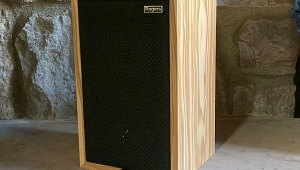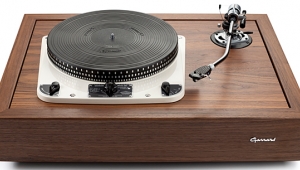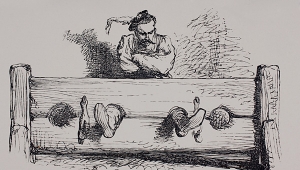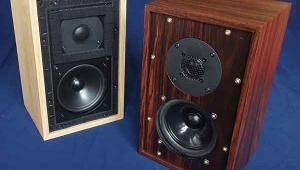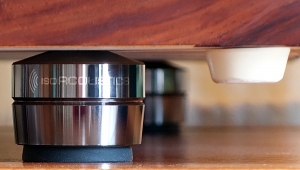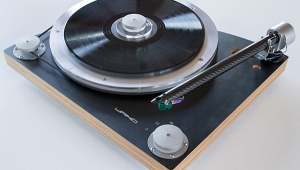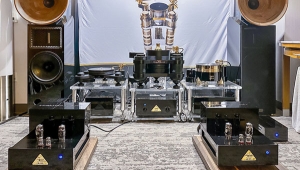| Columns Retired Columns & Blogs |
Listening #94 Page 3
Have you outgrown your doctor?
Speaking of noise, when I first installed the Shindo Vosne-Romanee preamplifier in my system—alongside my Thorens TD-124 turntable, EMT 997 tonearm, various EMT and Ortofon pickup heads, Shindo Corton-Charlemagne amplifiers, and Audio Note AN-E/Spe H/E loudspeakers—the most remarkable thing I heard was: nothing. I nonetheless left the volume control turned up about a quarter of the way, and went ahead and put a record on the Thorens. When I lowered the needle to the groove, the sound it made startled the hell out of me. I put the tonearm back in its resting position and cranked the volume to about two-thirds of full: still no noise. I rotated the source-selector switch through all of its positions and back again, and noted that the Vosne-Romanee is the first preamp of my experience with which I could not depend on the noise level to tell me if it was set to Line or Phono. Throughout all of the volume control's normal range and quite a ways beyond, there was no audible noise, and no audible difference between the two input types.
Footnote 4: This, I imagine, is why Ken Shindo recently changed his preamp labeling scheme to move the selection for TV (!) next to that for Phono on the rotary switch: I can think of no source more sacrificeable than a television.
Speaking of noise, when I first installed the Shindo Vosne-Romanee preamplifier in my system—alongside my Thorens TD-124 turntable, EMT 997 tonearm, various EMT and Ortofon pickup heads, Shindo Corton-Charlemagne amplifiers, and Audio Note AN-E/Spe H/E loudspeakers—the most remarkable thing I heard was: nothing. I nonetheless left the volume control turned up about a quarter of the way, and went ahead and put a record on the Thorens. When I lowered the needle to the groove, the sound it made startled the hell out of me. I put the tonearm back in its resting position and cranked the volume to about two-thirds of full: still no noise. I rotated the source-selector switch through all of its positions and back again, and noted that the Vosne-Romanee is the first preamp of my experience with which I could not depend on the noise level to tell me if it was set to Line or Phono. Throughout all of the volume control's normal range and quite a ways beyond, there was no audible noise, and no audible difference between the two input types.
I did, of course, progress to music—and it sounded wonderful. The sound of the Vosne-Romanee was lush and richly colored, just as my experience with certain vintage tubes, transformers, and other components has led me to expect. But the V-R played records in a manner that was much more explicit than I expected: musically explicit, and sonically very detailed.
Being no more disciplined in my perceptions, and certainly no more intelligent, than the average audio hobbyist, I reflexively assumed that the Vosne-Romanee's greater detailing than my own Shindo Masseto meant that it must surely sound brighter than its less expensive stablemate. But when I swapped the Masseto back into the system, I realized that it was actually the brighter-sounding of the two, howsoever slightly. The V-R in fact sounded darker overall, with richer and more saturated colors, and with textures deeper than I'd heard before from my system, the relief of which (for want of a better word) was defined more by shade than by sun. The Vosne-Romanee was vernal in content, autumnal in style.
Here is perhaps the feyest thing I've ever written (don't expect me to make a habit of it): If music were a collection of paintings and sculptures, the Vosne-Romanee would be a gallery darker than the average, but with much clearer, stronger lighting trained on each individual work. Lacking that degree of resolution and sophistication, the Masseto really was the brighter and counterintuitively less detailed preamp—as was pretty much everything else.
I'll return to Earth with four specific observations. First, as with the Masseto, I continued to prefer the Hommage T1 step-up transformers to the ones built into the Shindo, although the latter sounded quite fine, and the former, like all outboard units, required me to dress their cables and angle their housings just so, to avoid spoiling the Vosne-Romanee's otherwise perfect humlessness.
Second, also like the Masseto, the Vosne-Romanee can be adapted to provide, for the owner who doesn't mind giving up one of its four stereo pairs of line-level inputs, a true mono phono input. It's as simple as disconnecting the hot leads from the line input of your choice (logic and convenience conspire to dictate that this would be the next input over from phono, footnote 4), soldering a jumper from the left channel of the phono input to the left channel of the source selection you've just evicted, and soldering a jumper between the latter selection's left- and right-channel tabs. My Masseto preamp was modified in just that way by Ken Shindo before I bought it, but the change is easy to make in the field.
Third, the Vosne-Romanee's volume control seemed much more gradual than the Masseto's in the lowest part of its range: an unambiguous improvement, in my opinion. (As it turns out, both preamps use the same potentiometer type, so the difference must be accounted for by different impedance characteristics in the surrounding circuitry.)
Fourth: On this sample of the Vosne-Romanee (serial no.034), which I believe is from the model's second or third production run, the acrylic front panel is cosmetically different from that of its predecessors. This panel has a filigree of art deco–ish gold lines around the proscenium arch of its tube window, yet lacks the expected gold band at its perimeter.
Shindo electronics have been, for me, nothing short of revelatory. That isn't because I find them to be useful tools, and certainly not because they appeal to my otherwise thrifty nature as a consumer—Not hardly, as we say in upstate New York—but because they simply delight me. Without meaning to condescend: When you've had enough of spending thousands of dollars on the kind of sound that the gurus say you ought to like, and you're ready to please yourself by spending your money on gear that you stand a chance of loving and keeping and handing down to your descendants, you can do no better than this brand. These are the Western Electric Model 93s, the Leak Stereo 20s, the Marantz Model Sevens of the future. Obviously. For the here and now, the Shindo Vosne-Romanee is simply the most musically insightful, emotionally captivating, intoxicatingly beautiful, and thoroughly pleasant-to-use preamplifier I've had in my home. It isn't just expensive, it's valuable. I'll be a sorry sack of sadness when it has to go back.
Footnote 4: This, I imagine, is why Ken Shindo recently changed his preamp labeling scheme to move the selection for TV (!) next to that for Phono on the rotary switch: I can think of no source more sacrificeable than a television.
- Log in or register to post comments


